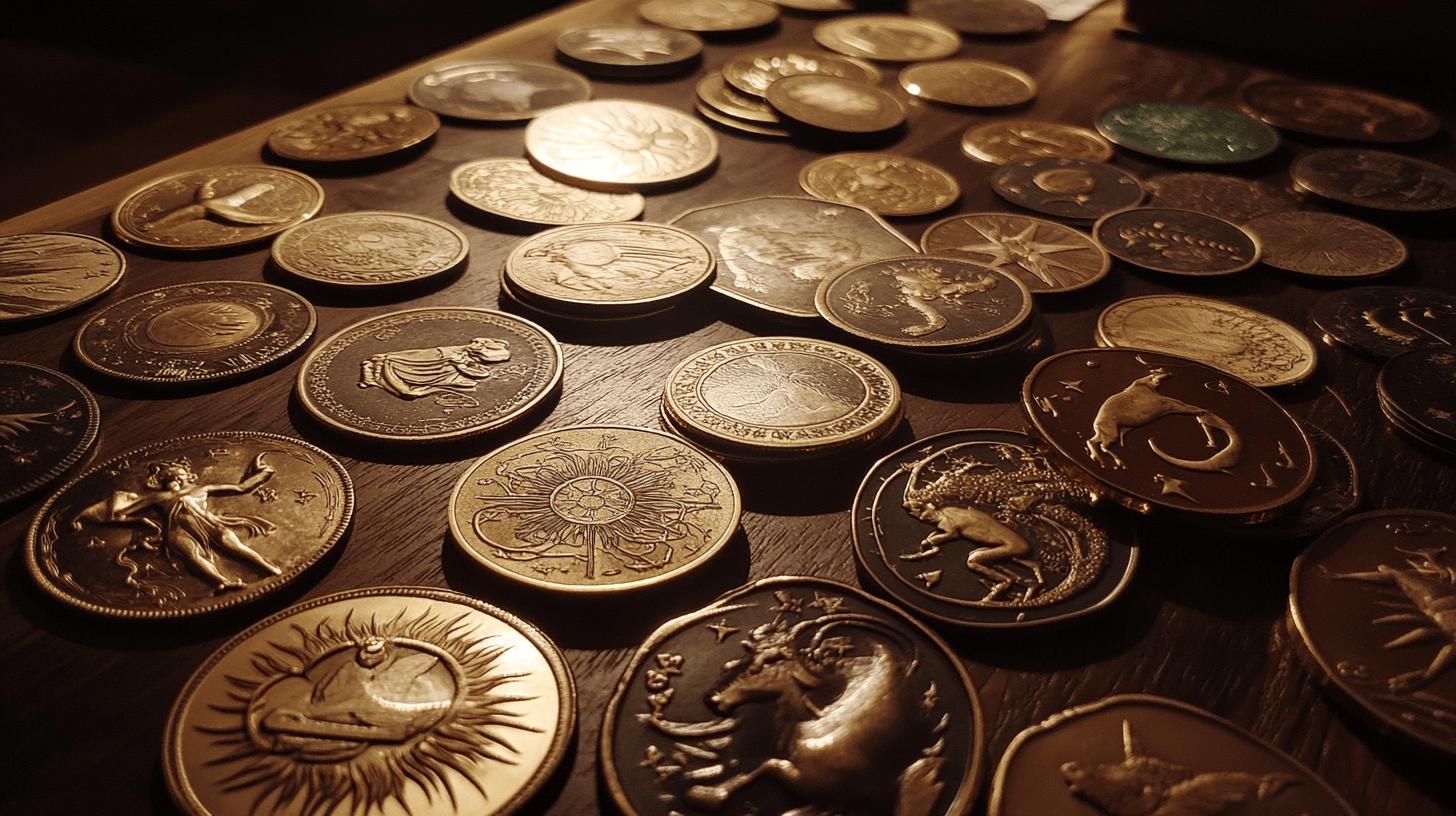Ever wonder if the soft shimmer of Venus (money magnet) could steer your investments better than any trading app?
Ready?
By tracking astrology transits (planetary journeys), you’re tuning into your natal chart (your birth snapshot) and catching the sky’s real-time cash currents.
Imagine feeling Jupiter’s warm glow hinting at perfect buy windows. Then sense Saturn’s cool shadow nudging you to pull back.
You’ll spot smooth trines (120° angles) lifting profits and tense oppositions (180° pulls) warning you when to step aside.
In this guide, you’ll learn a clear, step-by-step way to weave these star patterns into reliable money forecasts. Oops, I mean proven financial insights.
Astrology Transits for Precise Financial Forecasting
Think of financial astrology transits (planetary journeys) as the planets’ live GPS for your money story. You map the sky’s current cosmic positions onto your natal chart (your birth snapshot) to spot economic rhythms and market shifts. It’s like tracking Jupiter’s shimmer guiding your investments.
Then you watch how planets form aspects (the angles they make). Those patterns hint at calm growth zones or twisty corrections. In market timing astrology (forecasting buy-sell windows), you look for friendly aspects like trines (120°) and sextiles (60°) for sunny gains. And watch squares (90°) and oppositions (180°) for tension. That way, you surf market waves a little more confidently.
The main transit aspects shape your wealth forecasts. Here’s a quick breakdown:
- Conjunction (0°) is when two planets merge energy, sparking strong drive or fresh starts.
- Trine (120°) brings a smooth flow that can boost profits and ease market moves.
- Sextile (60°) offers gentle support, opening doors to new opportunities.
- Square (90°) tests your investments with friction, often leading to shake-ups.
- Opposition (180°) feels like a pull between forces, signaling peaks or pullbacks.
Knowing these angles helps you read financial astrology transits with clear, step-by-step insight.
Lunar timing and Mercury retrograde add extra layers to transit wealth predictions. New moons (the sky’s fresh reset) plant seeds for buy signals. Full moons (your trend’s peak glow) mark points where you might consider selling. During Mercury retrograde (when Mercury appears to move backward), um, miscommunications and delays pop up, so it’s wise to pause before major trades or contract signings. This blend of lunar cues and planetary moods makes your market timing astrology more nuanced and alive to real-time shifts.
Key Planetary Cycles in Financial Astrology Transits Predictions
Feel the soft shimmer of Jupiter (the planet of abundance) as it swings back every 12 years. And when it aligns just right, you’ll notice a warm glow in consumer confidence and banking sectors. It’s like a gentle nudge telling you to think long term. Tracking Jupiter transits (Jupiter’s path through your chart) helps you spot those sweet windows for big buys.
Saturn (the planet of structure) takes about 29.5 years to circle the sun. When it shows up, it’s time to tighten belts and double-check budgets. Um, you might feel a cool ripple of caution in markets – lean years, credit crunches, or even market lows. Use these Saturn transits to plan ahead, so you don’t overreach when the vibe turns serious.
Uranus (the planet of innovation) drifts on an 84-year journey around the sun. Its surprise visits can spark sudden shifts in tech, currencies, and real estate. Imagine a bolt from the blue – market volatility that feels electric. Spotting those Uranus transits means you can adjust your positions before the shockwaves hit.
Watching these three planetary cycles – Jupiter, Saturn, and Uranus – gives you a cosmic roadmap for money matters. Blend cycle timing with aspect analysis (how planets interact) and you’ll know when markets are ready to expand, contract, or surprise. Below is a simple reference to keep these outer-planet vibes front and center in your transit-based forecasts.
| Planet | Cycle Duration | Typical Market Influence |
|---|---|---|
| Jupiter (the planet of abundance) | 12 years | Bull markets, economic expansion |
| Saturn (the planet of structure) | 29.5 years | Contraction, restructuring, budget caution |
| Uranus (the planet of innovation) | 84 years | Tech breakthroughs, volatility spikes |
Financial Predictions With Astrology Transits Deliver Proven Gains

The Second House (your pocketbook: income, assets, and spending) shows you when your salary might shift or how your savings grow. Notice when a planet slides through here, you might feel the soft shimmer of Venus guiding your paycheck or sense a tweak in your side gig’s value. Have you ever seen Jupiter trine this house and felt an unexpected bonus land in your account?
The Eighth House (shared resources like debts, loans, inheritances, and financial partnerships) shines a light on teamwork in money matters. When planets roll through here, you’ll spot joint-finance events, loan approvals, trust fund releases, or partner investments, that feel like cosmic signals lighting up your shared ledger. It’s a reliable cue you don’t want to miss.
The Tenth House (your career spotlight: reputation and long-term earnings) aligns with career moves and public success. Watch for planets dancing through here and notice the golden glow of opportunity, promotions, raises, or that big business expansion could be on the horizon. And when Uranus pops into this house, expect sudden leadership roles or a fresh leap into the limelight.
Ready to put house transits (when a planet moves through your chart) to work? Start by mapping each planet’s path through your Second, Eighth, and Tenth Houses. Think of conjunctions as fresh starts, squares as gentle warnings, and trines as money-magic moments. Blend these house-specific cues with aspect timing to sharpen your market moves and personal finance timing, um, trust that star-guided calendar.
Financial Predictions With Astrology Transits Deliver Proven Gains
In financial astrology transits (when planets move against your chart), simple steps help you cut through cosmic noise. You begin by matching your asset’s IPO chart (the chart for its first trade) with today’s planetary patterns. That mix of chart angles and real-world money moves turns abstract star talk into a clear map you can follow.
You can use astrology transit software (tools that track planetary movement) or a classic ephemeris (a calendar of planet positions). These transit-tracking tools slide each planet’s shift right into your timeline. Then you might spot a Sun trine Jupiter (a friendly 120-degree angle) or Mercury square your asset’s main point (a 90-degree challenge). No more wondering if Mercury’s retrograde (when Mercury seems to go backward) will rattle your trades.
Ready for a simple six-step plan?
- Get the asset’s IPO chart (its first-trade horoscope).
- Use transit software or your ephemeris to list where planets will land next.
- Look for major aspects (angles like conjunction – planets side by side, trine – 120 degrees, square – 90 degrees, opposition – 180 degrees).
- Check how those aspects fall into the 2nd house (your money zone), the 8th house (shared resources), and the 10th house (career spotlight).
- Mark retrogrades (like Mercury retrograde when Mercury looks backward). Use extra caution when making moves.
- Blend these star signals with your market data – earnings, sector trends, whatever you follow.
Try jotting each transit into a spreadsheet to spot patterns. Then mix these cosmic hints with earnings reports or sector stats for a well-rounded view. Over time you’ll tune into the market’s star rhythms – like hearing a soft lunar whisper guiding your next move.
Financial Predictions With Astrology Transits Deliver Proven Gains
Have you noticed how market ups and downs often feel like déjà vu? Astrology transits (when planets form angles in the sky) can clue you in on these repeating moods. Let’s explore four cosmic snapshots, times when the stars lined up with big financial shifts. Studying these past dances helps you nail your timing and manage risk more wisely.
Back in 2008, we saw a Venus–Saturn opposition (planets 180 degrees apart) as markets froze with fear and contraction. Venus (value and social mood) sat opposite Saturn (structure and caution), creating a tense cosmic tug-of-war. Gold responded like a safe harbor, soaring from under $800 an ounce to over $1,900. If you’d held gold funds then, you’d have softened the blow.
Remember December 2020? A rare Jupiter–Saturn conjunction (planets side by side at 0 degrees) only happens about every 20 years. Jupiter (expansion) and Saturn (structure) locked hands just as economies thawed after COVID-19. You could almost feel consumer confidence warming and energy stocks rallying. That cosmic handshake ushered in a fresh bull market.
In April 2020, a harsh Venus–Neptune square (planets at 90 degrees) hit right as oil prices plunged into negative territory. Venus in retrograde (that backward drift) blurred our sense of value like a funhouse mirror. Traders who jumped off oil plays and held cash kept their footing when reality hit.
Looking ahead to November 20, 2025, a New Moon in Scorpio (new beginnings) will join Neptune at 29° Pisces and form a sextile (60 degrees) with Uranus at 29° Taurus. Picture a quiet cosmic reboot for shared resources, property, and partnerships. This feels like a deep under-the-surface makeover, ideal for fresh joint ventures. Watch for shifts in real estate trusts and private equity.
Timing Strategies and Tools for Financial Predictions with Astrology Transits

In your six-step plan, let daily Moon phases guide your cash-flow moves. Feel the cool ripple of lunar energy with each phase. A waxing Moon (growing light) brightens surprise deposits. New Moon (fresh lunar start) marks prime buy windows. And Full Moon (peak glow) hints it’s time to exit. Keep your chart (your personal roadmap) close.
Each week, scan for Sun–Mars trines (when Sun and Mars form a smooth 120-degree angle) to spark bold trading energy. And have you noticed how Mercury retrograde (when Mercury seems to backtrack) can pause your moves? Um, those pauses are part of the dance.
Once a month, peek at slow movers like Saturn (planet of structure) sitting in your Second House (money zone). It’s your heads-up for mid-term budget trends!
Next, arm yourself with these tools:
| Tool | Purpose | Notes |
|---|---|---|
| Transit Software | Real-time aspect charts | Customize alerts for key finance transits |
| Ephemeris | Planetary dates lookup | Online or printed for quick reference |
| App Alerts | Ping you on major aspects | Set filters for your chart’s money houses |
| Spreadsheet Log | Record dates, aspects, houses, ideas | Compare patterns with earnings reports |
Limitations and Risk Management in Financial Predictions with Astrology Transits
Financial astrology transits (planets moving through key chart points) can feel like a soft shimmer of guidance. But lots of market pros raise an eyebrow at the idea since it lacks the full data stamp of mainstream finance. They’ll say the results bounce around too much. Heck, even the famous trader W.D. Gann urged us not to lean on transits alone without solid numbers and our own good sense.
Have you noticed how Mercury retrograde (when Mercury seems to move backward, messing with contracts and tech) can stall a deal just at the last second? I once felt that pull right before a big trade, thank goodness I waited.
In a risk-savvy approach, you mix those celestial nudges with earthbound numbers. Think company earnings, sector growth rates, cash flow checks, and big-picture macro data. Treat the harder aspects, like squares (90-degree angles) and oppositions (180-degree tensions), and Venus retrogrades (when Venus takes a backward swing, slowing money vibes) as yellow lights, not green lights. Keep your portfolio spread out so one rogue planet can’t tip your balance.
Use position sizing to keep your moves light when the planets shift fast. Backtest your transit signals against past market swings, note outcomes in a trading journal. Then tweak your game plan based on what really worked. This blend of astro-insights and fundamentals helps you sharpen your timing, boost your forecasting accuracy, and guard against sudden market ripples.
Remember, these celestial cues are just one lens on timing the market. Do your homework, own every decision, and stay alert to surprises. You might even chat with a financial or legal pro before acting on a stellar tip. Keeping ethics and clear judgment front and center will keep your strategy grounded.
Final Words
You explored the core of transit-based forecasting, defining planetary aspects and lunar signals.
Then you charted key cycles, Jupiter, Saturn, Uranus, and saw how they influence market mood.
We broke down house transits for income, shared resources, and career gains.
A clear six-step method showed you how to track aspects, flag retrogrades, and mix insights with fundamentals.
Case studies grounded these patterns in history, and strategic tools help you stay aligned daily, weekly, and monthly.
With thoughtful risk notes you’re ready to blend analysis with caution.
Now go forward with confidence: your roadmap to financial predictions with astrology transits awaits.
FAQ
Where can I find financial astrology discussions on Reddit?
Financial astrology discussions on Reddit can be found in r/FinancialAstrology for market-timing tips, r/Astrology for chart insights, and r/WallStreetAstrology for crowd-sourced trend forecasts.
What transits indicate money and which ones are luckiest?
Transits indicating money include Venus or Jupiter forming a trine or sextile (harmonious aspect) to natal finance points. Jupiter return and Venus trines are often the luckiest for income gains.
How can I predict money in astrology?
Predicting money in astrology involves tracking planetary transits against your natal chart. Focus on second-house and tenth-house transits, Jupiter aspects for growth, and New Moons for fresh financial opportunities.
Which house or asteroid relates to wealth in astrology?
The second house (income and assets), eighth house (shared resources), and tenth house (career earnings) govern wealth. Asteroid Fortuna (the money asteroid) highlights areas where luck and abundance flow in your chart.
Which planet is responsible for finance?
Venus governs day-to-day cash flow and spending, Jupiter oversees growth and abundance, and Saturn sets budgetary limits. Together they balance your financial style and long-term prosperity potential.
Do Scorpios or other zodiac signs attract wealth?
Scorpios often tap deep intuition for transformative deals and abundance. Taurus attracts steady income through practical comforts, Capricorn builds wealth via disciplined career paths, and Leo shines in leadership-driven cash flow.
What transits help predict lottery wins?
Lottery-winning transits often involve fast-moving bodies like the Moon or Mercury activating your chart’s apex. A New Moon conjunct your second-house ruler or a Jupiter aspect can trigger unexpected windfalls.



